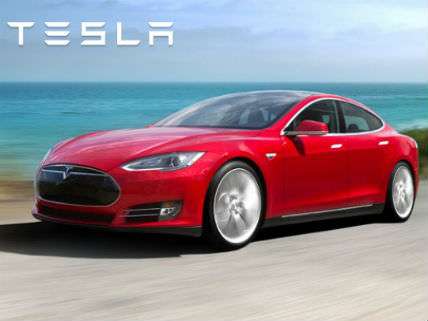The Tesla Tax Break and Other Green Tax Credits Go Mostly to the Rich - Surprised?
The top income quintile received about 90 percent of all electric and hybrid car tax credits.

Do poor people drive Tesla roadsters? Not exactly. The average household income of Tesla owners is just shy of $300,000 per year. Low end models begin at $70,000 but rise to over $105,000. Fortunately, the Feds take a bit of the sting out of the price by handing over a $7,500 tax credit to purchasers of electric cars. A new study, "The Distributional Effects of U.S. Clean Energy Tax Credits," by two energy economists at the University of California, Berkeley finds that the rich are the chief beneficiaries of billions in federal tax credits aimed at encouraging people to buy and install energy efficient and low-carbon technologies. From the study:
There is wide agreement among economists that the best policy to reduce greenhouse gas emissions and other negative externalities from energy use would be to use a tax or cap-and-trade program. Although there has been some movement in this direction, the vast majority of energy-related externalities worldwide remain unpriced.
Instead, the approach that is receiving increased attention, mostly in richer countries, is to subsidize lower-greenhouse gas alternatives to traditional fossil-fuel based technologies. It can often be easier politically to introduce subsidies than taxes, but the two are not equivalent.
And if the subsidies go mostly to rich people, that surely makes the politics all that much easier to navigate. Looking at tax credits since 2006 awarded for solar panel installation, weatherization, electric car purchases and so forth, the researchers report:
We focus on four major tax credits for individuals aimed at encouraging households to weatherize their homes, install solar panels, and to buy hybrid and electric vehicles. Since 2006, tax expenditures for these clean energy" tax credits have exceeded $18 billion. …
We find that these tax expenditures have gone predominantly to higher-income Americans. Overall, the bottom three income quintiles have received about 10% of all credits, while the top quintile has received about 60%. The most extreme is the program aimed at electric vehicles, where we find that the top income quintile has received about 90% of all credits. We show that the distributional pattern is similar across years and reflects that higher-income taxpayers are much more likely to claim credits and for signicantly larger credit amounts.
Whereas tax credits are received disproportionately by high-income households, a carbon tax would be paid disproportionately by high-income households. Hassett et al. (2009), for example, find that with a carbon tax the top income quintile would pay about four times as much as the bottom quintile. It would seem difficult, therefore, to prefer tax credits over a carbon tax on distributional grounds. There may well be political considerations that continue to favor tax credits, but this approach comes at real cost, both in terms of efficiency and equity.
Well, yes.
I can't help wondering if fierce egalitarians like Senators Bernie Sanders (I-VT), Dianne Feinstein (D-CA), Charles Schumer (D-NY), Harry Reid (D-NV) knew that they are subsidizing rich celebrities like Stephen Colbert, Steven Spielberg, and Will Smith when they voted in favor of tax credits for new qualified plug-in electric drive motor vehicles? I am sure their intentions were good.
